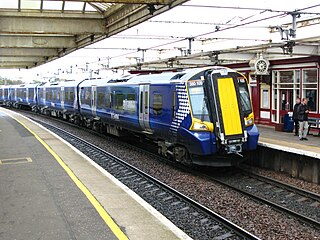
Glasgow Central, usually referred to as just Central or Central Station, is one of two principal mainline rail terminals in Glasgow, Scotland. The railway station was opened by the Caledonian Railway on 1 August 1879 and is one of 20 managed by Network Rail. It is the northern terminus of the West Coast Main Line. As well as being Glasgow's principal inter-city terminus for services to England, Central also serves the southern suburbs of the Greater Glasgow conurbation, as well as the Ayrshire and Clyde coasts. The other main station in Glasgow is Glasgow Queen Street.

The Ayrshire Coast Line is one of the lines within the Strathclyde suburban rail network in Scotland. It has 26 stations and connects the Ayrshire coast to Glasgow. There are three branches, to Largs, Ardrossan Harbour and Ayr, all running into the high level at Glasgow Central.

The British Rail Class 311 alternating current (AC) electric multiple units (EMU) were built by Cravens at Sheffield from 1966 to 1967. They were intended for use on the line from Glasgow Central to Gourock and Wemyss Bay, which was electrified in 1967.

The British RailClass 303 electric multiple units, also known as "Blue Train" units, were introduced in 1960 for the electrification of the North Clyde and the Cathcart Circle lines in Strathclyde. They were initially classified as AM3 units before the introduction of the TOPS classification system, and were the dominant EMU on the Glasgow suburban railway network for over 25 years before being progressively phased out by newer rolling stock. The final units were withdrawn from service in 2002. The fleet's lifespan was 42 years.

The Inverclyde Line is a railway line running from Glasgow Central station through Paisley and a series of stations to the south of the River Clyde and the Firth of Clyde, terminating at Gourock and Wemyss Bay, where it connects to Caledonian MacBrayne ferry services. The line has been in operation since the 1840s between Glasgow and Greenock and was the first passenger service to follow the River Clyde to the coast. The line was electrified in 1967.

The British Rail Class 318 is an electric multiple unit (EMU) passenger train which operates in west central Scotland. The units were introduced on 29 September 1986 as part of the electrification of the Ayrshire Coast Line between Glasgow Central and Ayr/Ardrossan with alternating current (AC) overhead lines. Their use was extended to Largs in January 1987. They were also used on the Inverclyde Line in small numbers. The trains currently operate Argyle Line, Cathcart Circle Line, North Clyde Line, Whifflet Line and Inverclyde Line services. Following the withdrawal of the Class 314 fleet in 2019, these units are the oldest working EMUs in Scotland, having been in revenue-earning service for more than 37 years.

Greenock West railway station is a station in Greenock, Scotland, located on the Inverclyde Line which runs from Gourock to Glasgow Central. The route is currently operated by ScotRail under the auspices of Strathclyde Partnership for Transport. Each service to and from Glasgow on the Inverclyde Line stops at this station.

Port Glasgow railway station is on the Inverclyde Line, serving the town of Port Glasgow, Scotland. It is located in the town centre with the main entrance at the junction of Princes Street and John Wood Street.

Paisley St James railway station is on the Inverclyde Line, serving one of the residential districts of the town, just west of the town centre. For passengers travelling to the commercial district, Paisley Gilmour Street is the main railway station of Paisley and is located in the heart of Paisley town centre. There is an ongoing campaign to rename the station "Paisley St Mirren" due to the station's proximity to St Mirren's new stadium.

Paisley Gilmour Street railway station is the largest of the four stations serving the town of Paisley, Renfrewshire, Scotland, and acts as the town's principal railway station. The station is managed by ScotRail and serves the Ayrshire Coast Line and Inverclyde Line, 7+1⁄4 miles (11.7 km) west of Glasgow Central. The station is protected as a category B listed building.

Wemyss Bay railway station serves the village of Wemyss Bay, Inverclyde, Scotland. The station is a terminus on the Inverclyde Line, about 26 miles (42 km) west of Glasgow Central. The station incorporates the Caledonian MacBrayne ferry terminal connecting mainland Scotland to Rothesay on the Isle of Bute. The station is managed by ScotRail.

The Bellgrove rail accident occurred on 6 March 1989 when two passenger trains collided near Bellgrove station, Glasgow, United Kingdom. Two people were killed and 53 were injured. The cause was driver error, with a signal being passed at danger. The layout of a junction was a contributory factor.
Ding-ding, and away is a slang expression used by the UK media and railway enthusiasts to describe a type of operating incident in the British railway industry where the guard of a train standing at a platform gives a "ready to start" bell code to the driver, when the platform starting signal is at danger, and the driver then moves the train past the signal without checking it. This constitutes a signal passed at danger (SPAD).

The Glasgow Airport Rail Link (GARL) is a proposed link between Glasgow City Centre and Glasgow Airport. The original plans for an airport rail link were proposed during the 2000s to directly link Glasgow Central station with Glasgow Airport in Scotland. The link was intended for completion by 2013 and would have had a service of four trains per hour via Paisley Gilmour Street railway station.
On 21 July 1991, two commuter trains crashed just west of Newton railway station in Cambuslang, near Glasgow, Scotland. The junction had been remodelled in the month previous to the crash.
The Glasgow and Paisley Joint Railway was the section of railway line between Glasgow Bridge Street railway station and Paisley, in the west of Scotland. It was constructed and operated jointly by two competing railway companies as the stem of their lines to Greenock and Ayr respectively, and it opened in 1840. The Joint Committee, which controlled the line, built a branch to Govan and later to Cessnock Dock, and then Prince's Dock.
The Glasgow, Paisley and Greenock Railway (GP&GR) was an early Scottish railway, opened in 1841, providing train services between Greenock and Glasgow. At the time the River Clyde was not accessible to sea-going ships, and the intention was to compete with river boats that brought goods to and from the city. In fact passenger traffic proved surprisingly buoyant, and connecting steamer services to island resorts in the Firth of Clyde provided a very great source of business.
The Greenock and Wemyss Bay Railway was a railway owned by the Caledonian Railway, providing services between Greenock and Wemyss Bay.

The British Rail Class 380 Desiro is a type of electric multiple unit passenger train that operates on the National Rail network in Scotland, for ScotRail.














